Several weeks ago, I mentioned that Shakespeare’s Flowers in Stumpwork by Jane Nicholas was ready for pre-order, and you’ll be happy to know that it’s now out in several places.
Thanks to Jane, my copy came a couple weeks ago, and now that I’ve had a chance to peruse it thoroughly, I’ll review it for you!
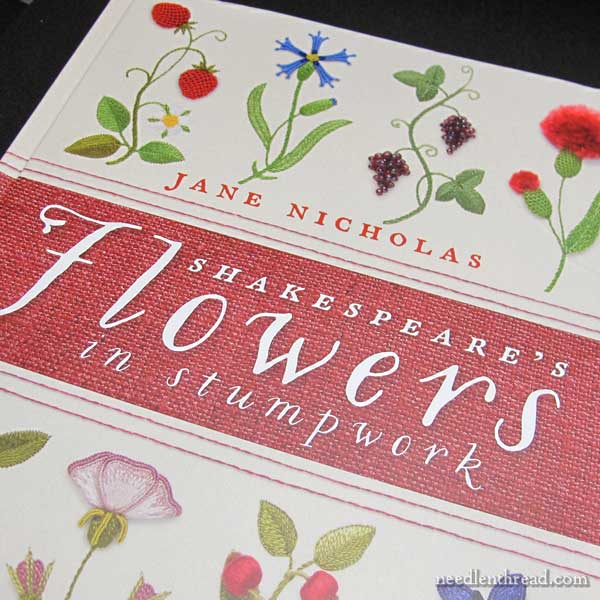
Shakespeare’s Flowers is a large book. It’s a somewhat heavy, hard-bound book with 272 pages – quite a tome! And so it should be, if you think about it. You’ve got two rather complex subjects right there in the title: Shakespeare and stumpwork!
It is a beautiful book, as far as the projects go and the visual layouts. I’m always a little disappointed in the quality of larger Milner Craft Series books (flimsy paper, not the best binding in the world), but given the size of the book and the price point, it’s understandable.
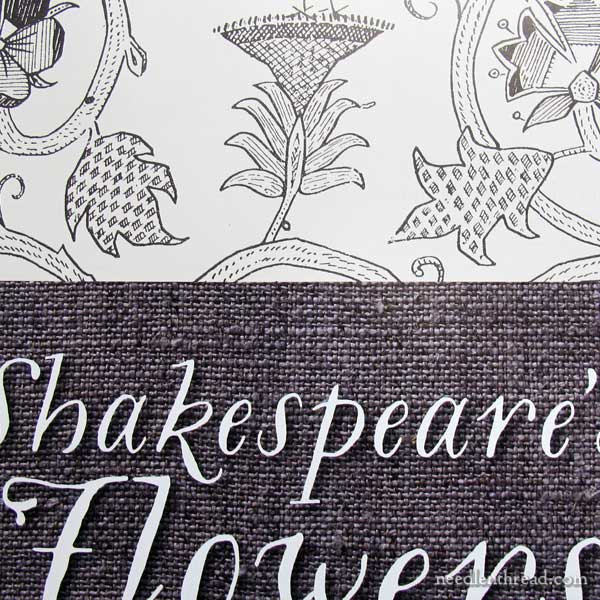
When I opened the book, I was delightfully pleased with the inside title pages. There are some fantastic black-and-white pen drawn backgrounds here, very 17th-century-embroidery-pattern-ish, which gave the book just the right “atmosphere” from the very first pages.
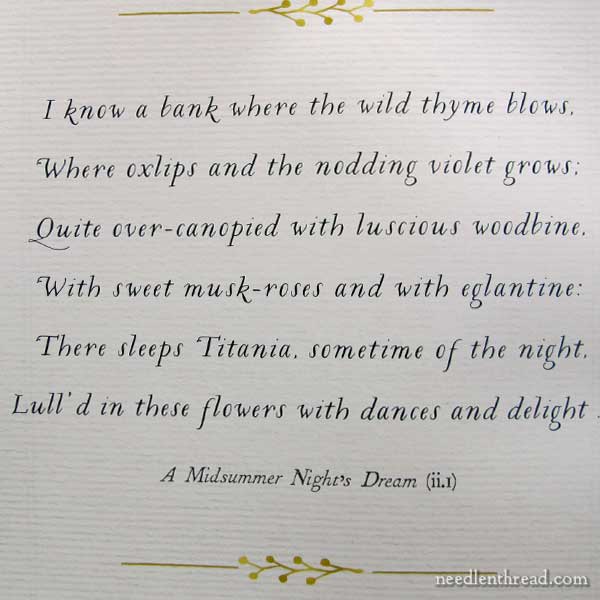
And of course, there are, throughout the book, nice smatterings of Shakespeare’s references to flowers. If you like Shakespeare, it’s just dreamy!
There’s also a very nice introduction, with historical information, explanations, and so forth. It’s well done and worth reading. I love it when there’s a good overview of historical context in embroidery books. It puts things in perspective and keeps the thread between past and present art intact.
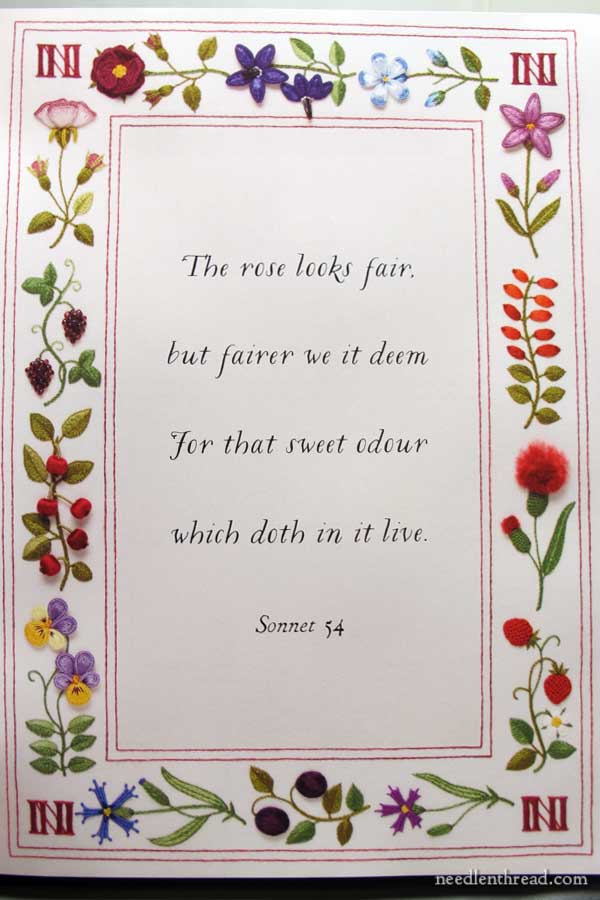
After the introductions all around, we move into the projects.
Now, technically, the book sports 14 separate projects – 12 small floral elements that can be worked a number of different ways (I’ll explain in a moment), plus an Elizabethan panel and a garland of spring flowers, the latter two being separate projects altogether.
Concerning the 12 small floral elements, these make up the projects in two sections of the book. The frame, above, is one possible project that can be worked with the floral elements, and it is the focus of the first section of the book. The following section offers other possibilities with the same floral motifs.
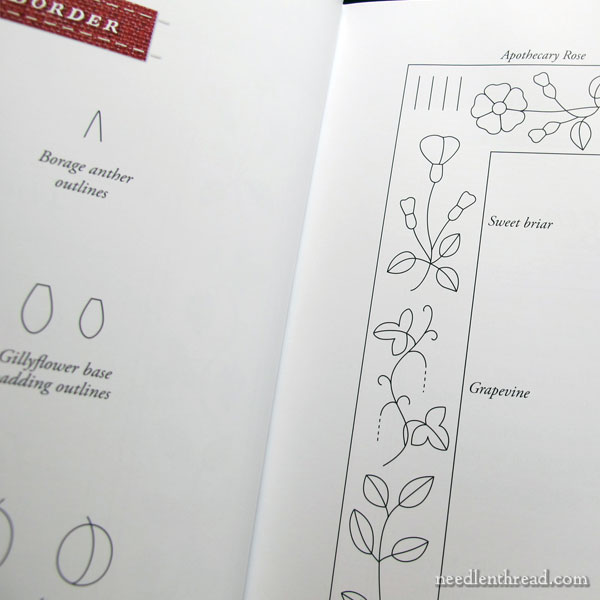
The project section begins with patterns for both the overall project and any small stumpwork elements within it. These are offered as traceable line drawings, and they are all quite small. Seeing the actual size of the patterns in the book (which are given at actual size – they aren’t meant to be enlarged), I was pleased as punch! The projects become much more manageable in the mind, when you realize they aren’t big.
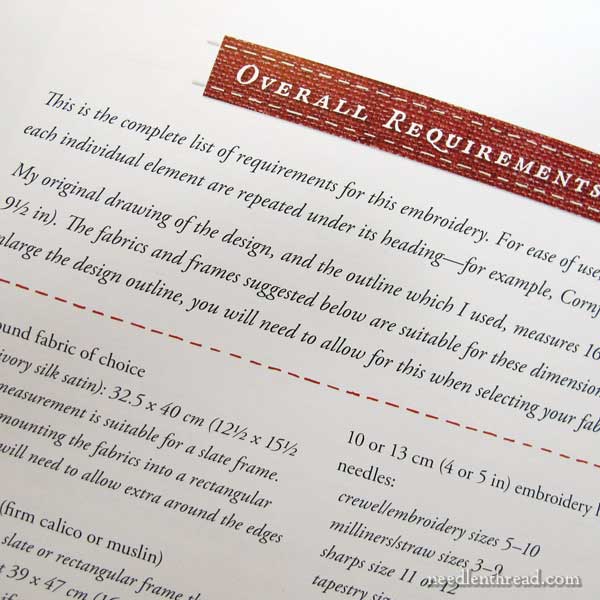
Following the patterns, you’ll find a list of overall requirements for the project in that section. With this particular project – the frame – the list is quite long, since it involves all the supplies for 12 individual little projects all rolled into one project.
The requirements list covers everything, from fabric to thread to tools to wires and beads and needles of various types and sizes. In short, everything you need to work the project.
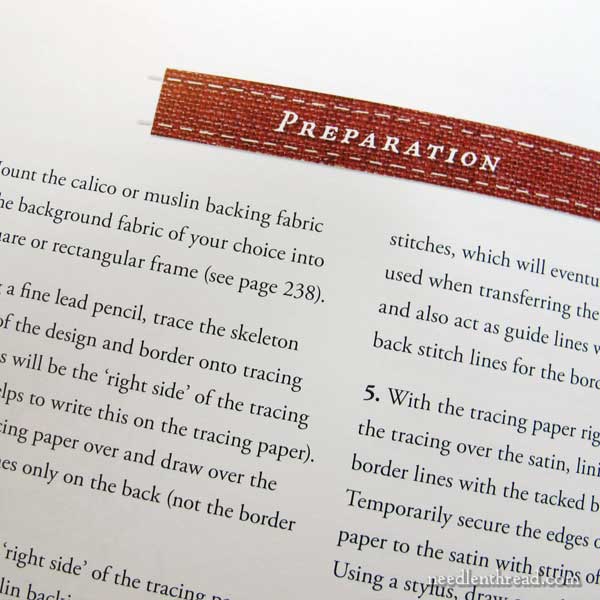
The next section covers preparation – how to set up your fabric, transfer your design, and so forth.
This is all text at this point, so if you’re used to highly visual books jammed with lots of pictures, understand that Jane’s books are not really that way. There’s a lot more text in her books than in most instructional needlework books today. Personally, I think this is a good thing. It doesn’t leave you guessing. As long as you can read, and as long as the author knows how to write and instruct (which Jane does, to a tee), you’ll understand what to do. When an image is necessary to clarify, you’ll find small line drawn illustrations.
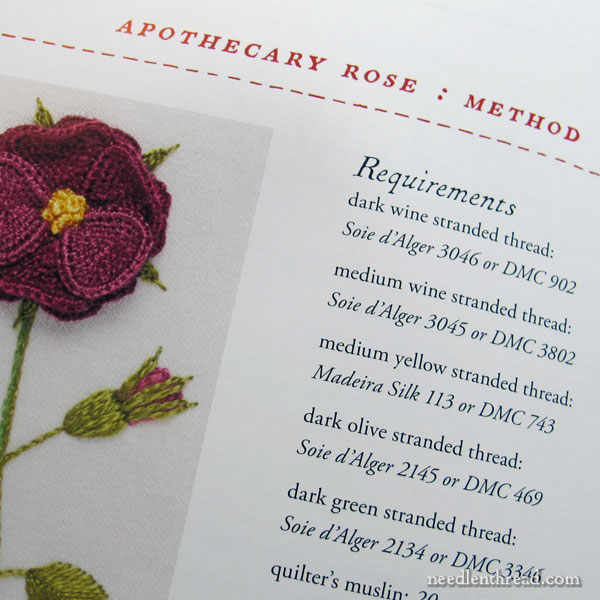
Next up, the project is broken down in parts. For the frame, that means each floral element is featured, with a supply list and instructions on how to complete the floral elements.
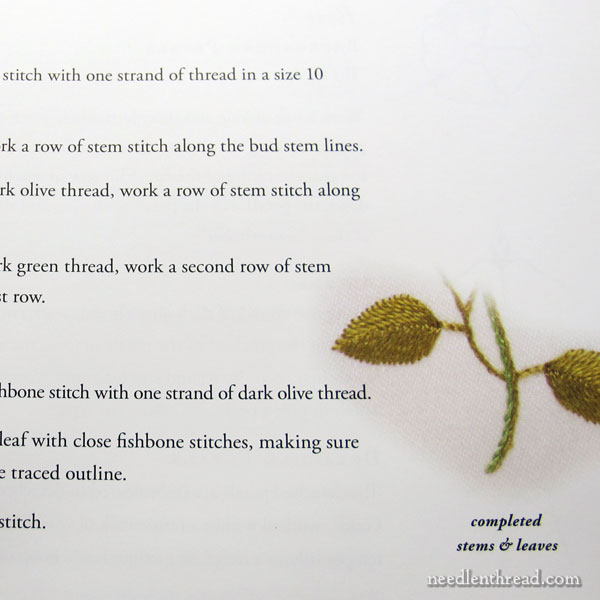
Again, you won’t see a lot of step-by-step photo instruction here. It’s all text, illustrated in the margins with close-up photos of the completed element relating to the particular instructions.
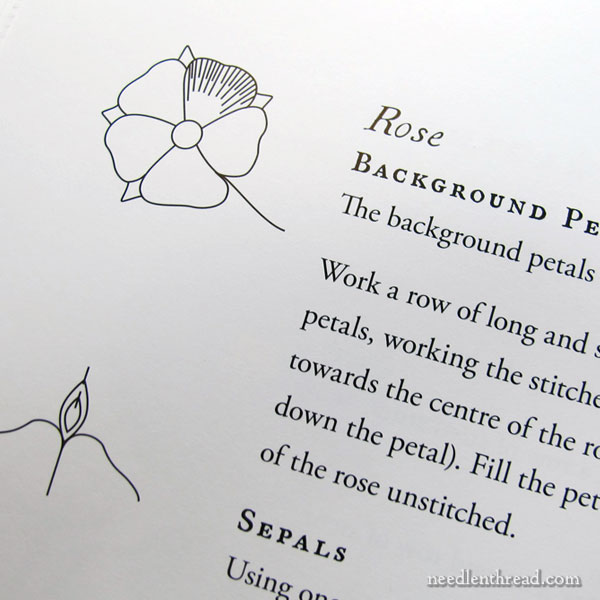
Where diagrams are required to clarify, you will find small line drawn diagrams in the margins next to the instructions.
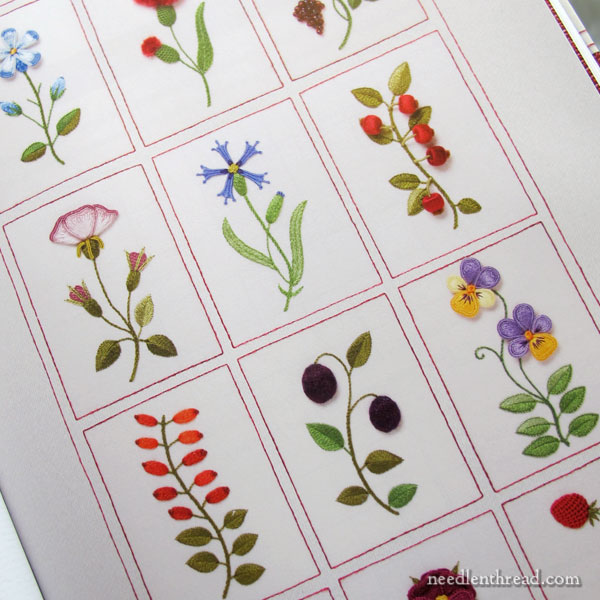
The next chapter of the book focuses on the samplers. These consist of all the floral elements in the frame, rearranged as small samplers.
Incidentally, you don’t have to arrange them in groups. You can work each element individually, in layouts of four, of six, of twelve arranged vertically or horizontally. Jane offers several layout arrangements for the samplers. I’m kind of taken with the idea of working them individually instead of in groups. There’s lots of leeway here for arranging things, anyway!
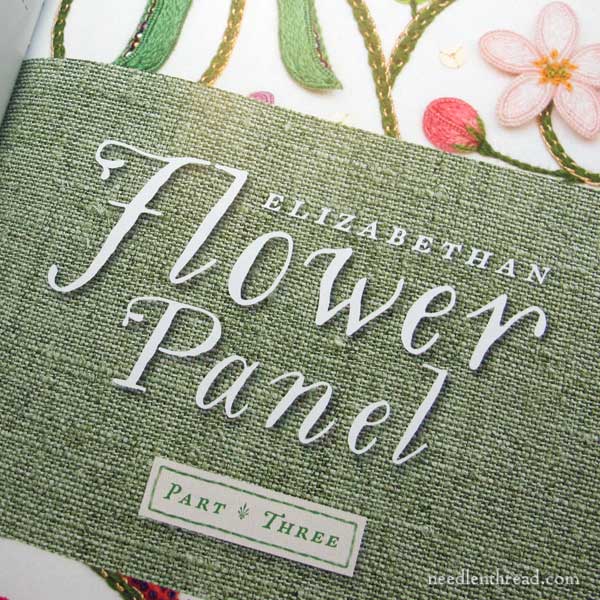
Next up, the Elizabethan Flower Panel, a lovely project which I showed you in the previous article on Shakespeare’s Flowers. The presentation of the project is the same – patterns, requirements, preparation, instruction.
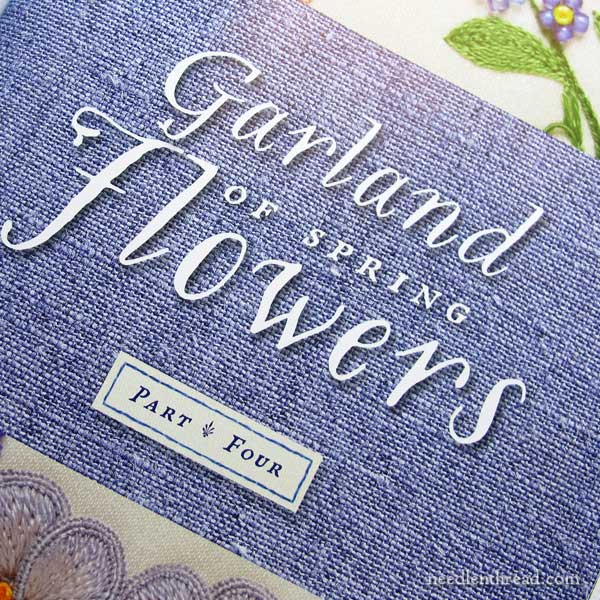
The the Garland of Spring Flowers is the final project in the book – it’s a lovely floral garland with snowdrops and pansies, featuring some little flowers made with beads.
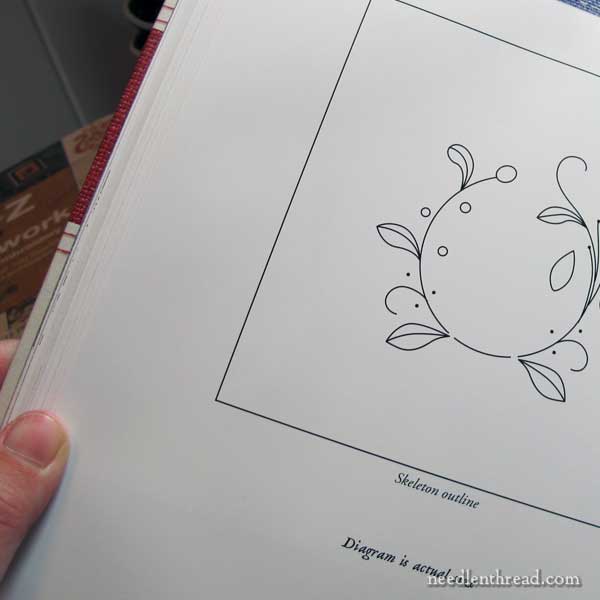
Just to show you what I mean by the pattern sizes – that’s my thumb in the lower left corner, so you can get a sense of the size of the projects.
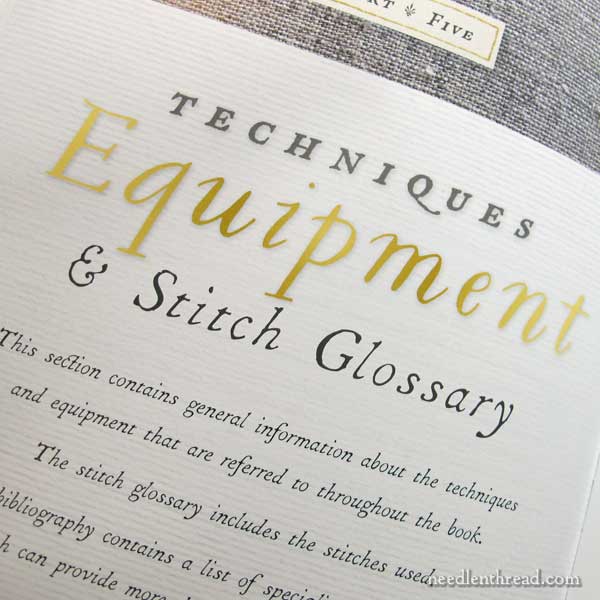
The last part of the book is devoted to techniques and stitch instructions. As you work through the projects, you’ll refer to this section for instructions on specific stitches or techniques if you need to.
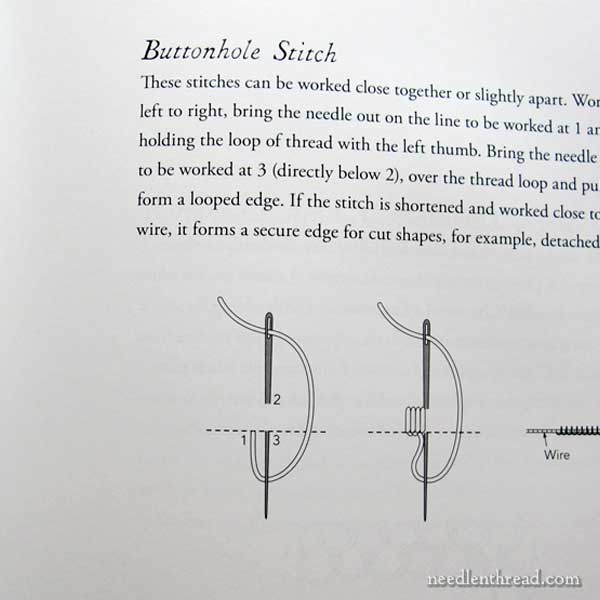
The instructions are simple diagrams and text, and they are very clear.
Summary
The book features absolutely beautiful projects, as all of Jane’s books do. It’s delightful to flip through to see the pictures of the projects and to read some of the little extras in the book. In that sense, it makes a great inspirational book and a pretty nice display book, too! If I had a coffee table, I’d have no problem keeping it there.
Mostly, though, it is an instructional book, and it is primarily text-based instruction. If you’re keen to work the projects within, be prepared to read! I don’t think there’s anything wrong with this – I like text-based instructions. But I know that there are many visual learners out there who are more used to photo and image-based instruction and who might find it problematic. Just so you know!
And that being said, this is not a beginner’s book, unless you’re an absolutely determined beginner who likes a challenge. If you’ve never done any stumpwork before, you might start with a beginner’s book and then progress to this. If you’ve worked your way through at least one stumpwork project before, though, you should have no problem with this book. It’s accessible.
I thoroughly enjoyed reading the book cover to cover, and I have to admit, it’s given me the itch to work up some of the floral motifs. Should I give in? Probably!
Where to Find It?
You can find the book through the following book affiliates:
In the US, you’ll find Shakespeare’s Flowers in Stumpwork available through Amazon.
Worldwide, you can find Shakespeare’s Flowers available through Book Depository, with free shipping.







Dear Mary
Shakespeare’s Flower’s in Stumpwork looks a very detailed instructional and inspiring book with lots of scope to create lovely embroidery designs. I like the framed samplers which gives you the option of stitching a single or a group of pannelled elements and it’s always good to have a stitch glossery included. This looks a great book to have especially if you like stumpwork as I do and as a text based book there would be lots to read and lots to learn. Thanks for reviewing the book and for sharing your views with us.
Regards Anita Simmance
Would you give a recommendation for a beginner Stumpwork book?
I am a beginner to stump work. Please recommend me a suitable book
Thank you, Mary. This looks like a lovely book.
Thanks for posting this! I just pre-ordered! I am especially taken with the Elizabethan flower panel, and intend to get to work on that as soon as the book arrives!!!! So excited!
Mary I would love to get this book, but I’m afraid! I have never tried stump work – what book would you advise a beginner start with?
I’m very happy with my copy, which came a little while ago from Amazon. I love the way each part of the projects can be sewn individually if wished, so they would be small works completed quite quickly e.g. to make into a card for someone special.
I love Jane’s books–I have all of her early books although I have yet to stitch any stumpwork. They are just beautiful books and although pricey, when you consider the number of pages they really aren’t that costly. And so much background material that they are enjoyable just to sit and read. The instructions are very thorough, very detailed but like you said, you have to read. This book looks like another winner–will probably have to buy this one also.
Mary,
I need a good stumpwork book as a reference. Would this one work? Is there another that you would recommend? Thanks for your wonderful posts. I look forward to reading them daily.
I just went to Amazon.com and added this book to my wishlist. My daughter checks the list to buy me a book for my birthday and Christmas. I think that under $15 is a great price for this much information. Especially considering that the Book Depository is selling it for over $30.
I also checked Amazon and the Book Depository–the difference in price is that Amazon lists their book as soft cover and Book Depository lists as a hard cover.
Definitely adding this to my Amazon wish list! Thanks so much for the review. I have never done stumpwork, but I am a very determined beginner when it comes to mew techniques I just have to try out 🙂
It’s such a good price at Amazon that I bought it, and the more introductory Stumpwork Flowers. I hardly ever buy things (lack of cash, not lack of desire) but I’m very excited to get it!